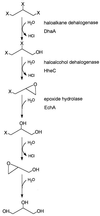Utilization of trihalogenated propanes by Agrobacterium radiobacter AD1 through heterologous expression of the haloalkane dehalogenase from Rhodococcus sp. strain M15-3
- PMID: 10508091
- PMCID: PMC91609
- DOI: 10.1128/AEM.65.10.4575-4581.1999
Utilization of trihalogenated propanes by Agrobacterium radiobacter AD1 through heterologous expression of the haloalkane dehalogenase from Rhodococcus sp. strain M15-3
Abstract
Trihalogenated propanes are toxic and recalcitrant organic compounds. Attempts to obtain pure bacterial cultures able to use these compounds as sole carbon and energy sources were unsuccessful. Both the haloalkane dehalogenase from Xanthobacter autotrophicus GJ10 (DhlA) and that from Rhodococcus sp. strain m15-3 (DhaA) were found to dehalogenate trihalopropanes to 2,3-dihalogenated propanols, but the kinetic properties of the latter enzyme are much better. Broad-host-range dehalogenase expression plasmids, based on RSF1010 derivatives, were constructed with the haloalkane dehalogenase from Rhodococcus sp. strain m15-3 under the control of the heterologous promoters P(lac), P(dhlA), and P(trc). The resulting plasmids yielded functional expression in several gram-negative bacteria. A catabolic pathway for trihalopropanes was designed by introducing these broad-host-range dehalogenase expression plasmids into Agrobacterium radiobacter AD1, which has the ability to utilize dihalogenated propanols for growth. The recombinant strain AD1(pTB3), expressing the haloalkane dehalogenase gene under the control of the dhlA promoter, was able to utilize both 1,2,3-tribromopropane and 1,2-dibromo-3-chloropropane as sole carbon sources. Moreover, increased expression of the haloalkane dehalogenase resulted in elevated resistance to trihalopropanes.
Figures




References
-
- Amann E, Brosius J. ATG vectors for regulated high-level expression of cloned genes in Escherichia coli. Gene. 1985;40:183–190. - PubMed
-
- Babich H, Davis D L, Stotzky G. Dibromochloropropane (DBCP): a review. Sci Total Environ. 1981;17:207–221. - PubMed
-
- Bagdasarian M, Lurz R, Rückert B, Franklin F C H, Bagdasarian M M, Frey J, Timmis K N. Specific-purpose plasmid cloning vectors. II. Broad host range, high copy number, RSF1010-derived vectors, and a host-vector system for gene cloning in Pseudomonas. Gene. 1981;16:237–247. - PubMed
-
- Belasco J G, Higgins C F. Mechanisms of mRNA decay in bacteria: a perspective. Gene. 1988;72:15–23. - PubMed
Publication types
MeSH terms
Substances
LinkOut - more resources
Full Text Sources

